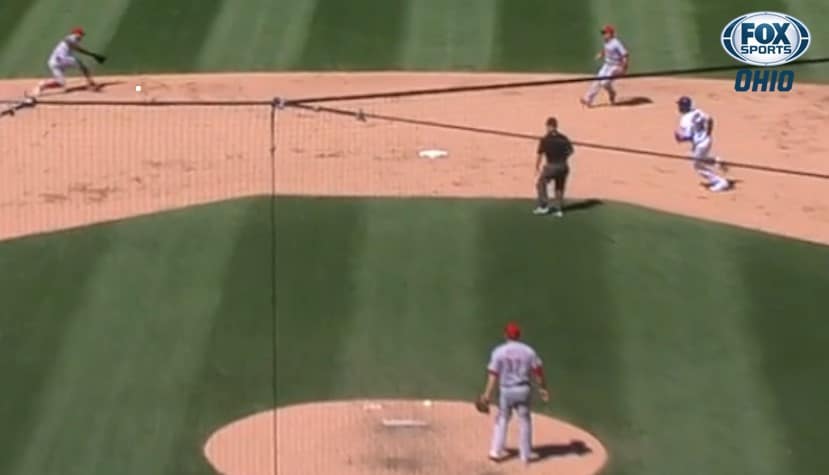
Reds-Cubs Rewind: Breaking Down Baez’s Flashy Glove Flip
The play of Javier Baez is a favorite subject for postgame analysis for many reasons. His aggressive style, athleticism, and high baseball IQ just create far more interesting game situations to analyze than the average player.
One such situation occurred in the 3rd inning Saturday against the Reds when Baez attempted a glove-flip to shortstop Addison Russell for an inning-ending force out. It did not work, and the next hitter connected on a three-run homer. Fortunately, another Cubs comeback turned this play into a footnote.
But the final score and whether Baez’s flashy play indirectly led to three runs or not are secondary. Factoring in such details only leads to what Joe Maddon calls “outcome bias.” But in the warm afterglow of consecutive comeback victories, what can a clear-eyed analysis of this play tell us?
Flashing back, the Reds were up 2-0 in the 3rd inning of a typically adventurous Chatwood start. The not fleet-footed Joey Votto stood on first following a two-out walk. Chatwood got Scooter Gennett to top a ball up the middle on the first-base side. The Cincinnati broadcast showed the best view of this and confirms Baez got an excellent break on the ball.

This was not an easy play. However, its most challenging aspects involved first reaching the ball and then gloving it. Combined with his good break, Baez impressively reached the ball without the need for a dive. He then kept his glove low enough to backhand the ball in stride.
By themselves, these two athletic efforts would make this a plus play. But neither are the kinds of athletic demonstrations that draw oohs and ahs during highlight replays. So Baez faced a choice when it came to finishing the play. Go for the higher percentage, “boring” textbook toss or make a highlight-reel glove flip.
The textbook move would be to take a stride and a half to transfer the ball to his right hand, squaring his shoulders, and shoveling the ball to Russell. This is not an unimpressive move, to be sure, but instead Baez opted to take one half-step less and attempt this:
If successful, the play surely would have made the highlight shows. However, the ball sailed high and a leaping Russell couldn’t catch it. Upon landing, Russell also had to contend with a fast-closing baserunner. Fortunately no contact resulted when he landed.
Defenders of Baez’s approach might suggest two things. One, Baez didn’t have time to take an extra half step and make the lower-risk toss with his throwing hand. But the replay does not support this. As the frame below clearly shows, Votto is just starting his slide after Baez has completed his glove-flip and Russell’s eyes track the ball starting its arc over his head.
Two, some might say instinct takes over on bang-bang plays and a player doesn’t have time to think. But Baez’s peripheral vision would give him a clear sense that non-speedster Votto would not beat his toss to second.
Plus, the instinct argument belies the reality that when good players make split-second decisions, their instincts seldom direct them to attempt something new and out of character. Most trained athletes will instead default to their drilled behaviors. In Baez’s case, we know he practices glove flips a lot. So he may well have defaulted to what he enjoys drilling and not the higher-percentage hand toss.

Whether Baez consciously or unconsciously chose the riskier option, other aspects recommend against it in the future. Forget the homer that followed and just consider the game situation of the Cubs being down 0-2 facing the heart of the Reds’ order. Failing to get that third out led to extra pitches (in this case 12 for Chatwood). Last, the glove flip accidentally created injury potential for his middle-infield partner from the oncoming baserunner.
For all these reasons – riskier play, game situation, added pitches and increased injury potential – Baez’s choice was not the optimal one when viewed with hindsight.
But live and learn for the 25-year-old All-Star, and a big tip of the cap to the whole team (including Baez’s solo homer in the 7th inning) for bailing out a bad start to the game and getting the win.
Rewind Redux
Jason Heyward’s great baserunning in the 7th inning of Sunday’s finale against the Reds will be rightly replayed a lot. You can watch it here, but take special note of the start of the play and how Reds shortstop Jose Peraza goes after Baez’s grounder. Here’s the best screencap I could find:

Peraza attempted a feet-first slide and an “alligator arm” reach at the ball that came just short of the three-hopper. With a head-first dive, Peraza had a chance to at least keep the ball on the infield and prevent Heyward’s heads-up merry-go-round the bases.
This same technique was spotlighted in a Cubs Insider “Rewind” feature last month. Fortunately in this case, the Cubs benefited.

